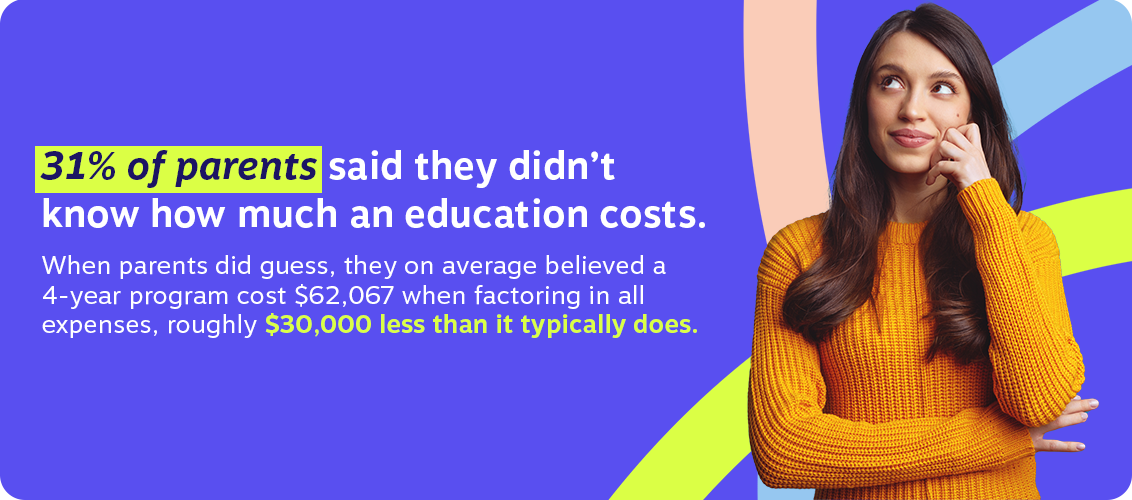81 per cent of parents believe it is their duty to help their child pay for their education, new poll finds
According to our latest poll, parents are stretching themselves thin in order to pay for their children’s education. The poll, which surveyed 1,000 parents across Canada, found that while Canadians are highly driven to save for their children’s education and understand the value of financially supporting their kids, current economic realities have forced many to make difficult decisions.
With a few tips and helpful strategies however, parents can confidently save for their child’s future without having to jeopardize their own.
Key Statistics:
- 81 per cent of parents believe it is their duty as a parent to help their child pay for their education.
- 52 per cent of parents polled would go into debt to pay for their child’s education.
- 31 per cent of parents did not know enough to even guess how much a Canadian education now costs.
- 73 per cent of parents polled believe it has been harder to save for their child’s education recently with prices and living expenses going up.
- 42 per cent expressed that the financial realities of paying for a post-secondary education will or has influenced the number of children they will have.
Parents’ Perspective on Education Savings
When asked, 89 per cent of parents polled stated they would like their children to pursue a post-secondary education, with 92 per cent expressing it would open doors for their kids.
However, it is clear that Canadians are keenly aware of the financial burden of post-secondary education and the impact it can have on students. Nearly all parents polled (93 per cent) believed that a post-secondary education is expensive, with 87 per cent stating that it is becoming increasingly unaffordable. In fact, 80 per cent of parents expressed that it is harder for students to afford an education now than it was when they were younger, and 69 per cent do not believe their child would be able to afford an education without their help. Two-in-three parents (66 per cent) even stated the more their child has to pay for their education, the harder it would be for them and the more likely it would be that they would drop out.
As a result, parents have put intense pressure on themselves to save for their children’s education, with 81 per cent expressing that it is their duty to help pay for it.
How much are parents hoping to contribute for their kids?
- Eighty-eight per cent of parents stated they would help pay for their child’s post-secondary education.
- Those willing to pay claimed they would help fund 71 per cent of their child’s education on average, with over 1-in-4 stating they would pay for it all (28 per cent).
- Eighty per cent would help their child pay for other expenses related to post-secondary school, like living expenses and rent.
“At Embark, we understand the immense pressure Canadian parents face when it comes to providing financial support for their children’s post-secondary education. The decisions made about education, whether it’s a university program or a trade school, have a significant impact on the rest of their lives,” said Andrew Lo, President and CEO of Embark, “That’s why we believe in our mission to make education more accessible to Canadians and help every family confidently navigate their post-secondary journey.”
Impact of Rising Costs
Inflation and the rising cost of living continues to have a heavy influence on Canadians, limiting their ability to save. Nearly three-quarters (73 per cent) of parents polled believe it has been harder to save for their child’s education recently with prices and living expenses going up, and almost half (47 per cent) stated they are currently living paycheque-to-paycheque. As of when the survey was conducted in May 2023, 40 per cent of parents polled had also stopped saving for their child’s education because of how much everything is now costing.
Many parents, however, are willing to prioritize setting their kids up for financial freedom at the cost of their own. Over half (52 per cent) of parents polled said they would go into debt to pay for their child’s education, and 61 per cent would prolong their retirement in order to help their child pay for their post-secondary education.
Due to these realities, 62 per cent of parents think saving for their child’s education can at times be overwhelming. Furthermore, 42 per cent expressed that the financial realities of paying for a post-secondary education will or has influenced the number of children they will have.
“We firmly believe that every Canadian family deserves access to a high-quality post-secondary education, and we are dedicated to making this a reality,” said Lo. “To accomplish our goal of empowering Canadians to realize their full potential, Embark offers a range of innovative technology, tools and resources designed to help families save for their child’s education. Our team of experienced professionals works tirelessly to deliver tailored solutions that meet the specific needs of each family, ensuring they can achieve their goals without suffering financial hardship.”
Click here to view national and provincial data related to the study.
Tips for Success when Saving in a Registered Education Savings Plan
Map out what you are saving for: One of the most important things that parents can do to help save for their child’s education is learn more about what they are saving for. Take time to understand how much an education costs and what you are willing and able to pay for. This way, you can build a realistic plan to reach your goal, alter your goal if it is too ambitious and set expectations with your child about what they will need to contribute.
When asked, 31 per cent of parents did not know enough to even guess how much an education now costs. When parents did guess, they believed a 4-year program cost $62,067 when factoring in all expenses, roughly $30,000 less than it typically does.
It takes a village: While times are tough, there are people out there that are always willing to help. The government, for instance, gives parents money to put towards their child’s education when saving in a RESP with grants like the Canada Education Savings Grant (CESG). The CESG can give families an extra 20 per cent in education savings on their first $36,000 contributed, if they save correctly.
However, only 46 per cent of Canadian parents polled knew about the CESG and even fewer (27 per cent) knew about the Canada Learning Bond, which is designed to help households with modest incomes help afford an education for their child. Embark helps families understand what they are eligible to receive and collects the funding for them, making sure families get the most out of their savings.
The best savings plan is a realistic savings plan: The most important thing any family can do is create a realistic savings plan that they can stick to. Parents do not need to go into debt to help save for their child’s school. Even a small amount saved over time goes a long way. If two parents save $50 a month each in a RESP since their child’s birth, they would have roughly $37,000 saved when their child is 18, when factoring in grants and a 4 per cent rate-of-return.
Time is your best friend: While you can start saving at any age, the more time you have, the more time your money has to grow. If you put your money in a tax-advantaged savings account, like an RESP, it can compound and grow even faster.
To get an estimate of how much your savings could grow over time, take a look at our online calculator.
Parents should never feel like they are on their own when saving for their children’s education. Embark helps approximately 600,000 Canadians every year with their RESPs. The Embark Student Plan is tailored to a child’s age and eases the burden on parents by maximizing every dollar in their RESP, automatically applying for government grants.
Media Contact
Joyce Li | joyce@talkshopmedia.com | 416-414-4797
An online survey of 1,000 Canadians parents with at least one child <18 in the household, was completed between May 5-12, 2023, using Leger’s online panel. No margin of error can be associated with a non-probability sample (i.e. a web panel in this case). For comparative purposes, though, a probability sample of 1000 respondents would have a margin of error of ±3.0%, 19 times out of 20.

Embark is Canada’s education savings and planning company. The organization aims to help families and students along their post-secondary journeys, giving them innovative tools and advice to take hold of their bright futures and succeed.






